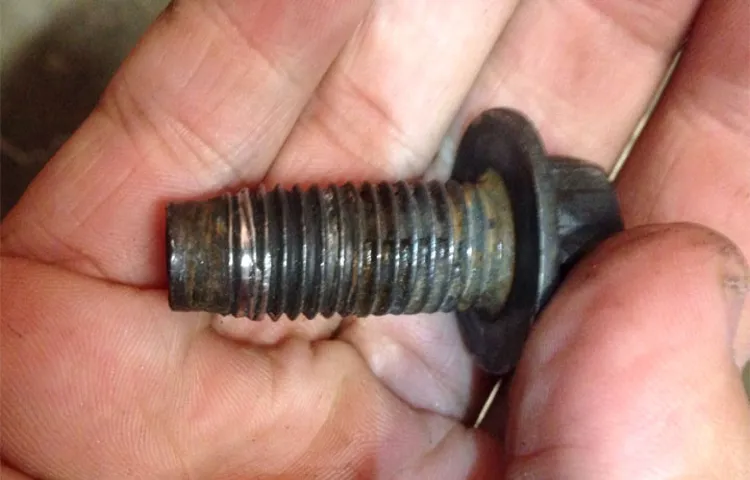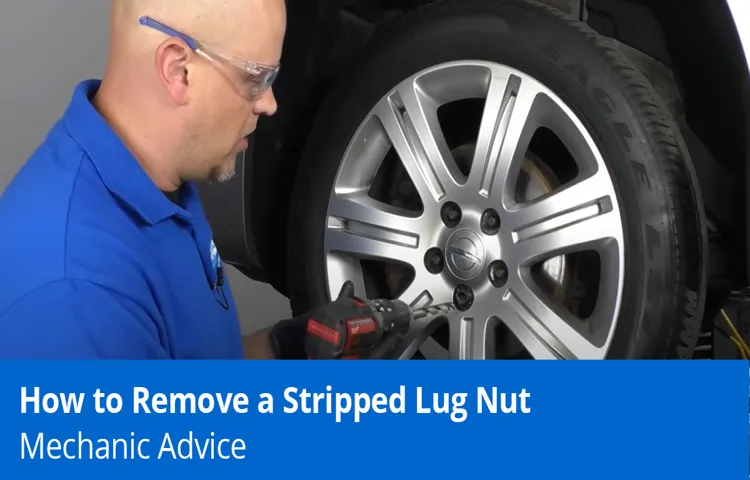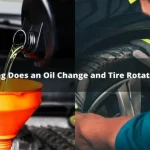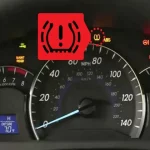Have you ever found yourself stuck on the side of the road with a stripped tire bolt? It can be a frustrating and time-consuming problem that requires a little bit of know-how to solve. But fear not, we’ve got you covered. In this blog post, we’ll take you through a step-by-step guide on how to remove a stripped tire bolt without damaging your car or causing more headaches.
Think of it as your trusty pit crew guide to getting back on the road in no time. So, grab your toolbox and let’s get to work!
Table of Contents
The Problem with Stripped Tire Bolts
Stripped tire bolts can be a real headache for any driver. They can occur due to wear and tear or through over-tightening. Trying to remove them can cause further damage to the tire and wheel, making matters worse.
However, there are several effective ways to remove stripped tire bolts without having to take your car to the mechanic. One of the easiest ways is to use a specialized bolt extractor socket. These sockets are designed with unique grooves that grip onto the bolt’s head, allowing you to turn the bolt and remove it without damaging the threads.
Another method is to use heat to loosen the bolt. By heating the area with a blowtorch and allowing it to cool down, you may be able to break the bond between the bolt and thread. It’s important to remember that prevention is key, so be sure to lubricate the bolts and use the correct torque settings when installing new tires.
With these tips, you can save money and time by fixing the problem quickly and efficiently.
What Causes Stripped Bolts
Stripped bolts can be a real pain, especially when dealing with tire bolts. But what causes them? The most common cause is overtightening. When bolts are tightened beyond their recommended torque, they can become stripped.
Another cause is corrosion, which can cause the threads to weaken and break when force is applied. In some cases, using the wrong tools or not using them properly can also cause stripped bolts. Whatever the reason, stripped bolts can be frustrating and time-consuming to deal with, especially when it comes to tire bolts.
It’s important to use the proper torque specifications and tools, and to regularly inspect the bolts for signs of damage or wear. Taking these preventative measures can help avoid the hassle of dealing with stripped tire bolts in the future.

Why You Need to Address the Problem ASAP
Addressing stripped tire bolts might not seem like a top priority, but ignoring the problem can lead to significant issues down the line. A stripped tire bolt means that the bolt has been damaged and can no longer be tightened or removed with a socket or wrench. This can occur due to various reasons, such as over tightening or corrosion.
Not being able to remove a tire bolt can cause serious issues, especially if you have a flat tire or need to change your tires in an emergency. Additionally, if the stripped bolt is not fixed or replaced, it can cause further damage to your car’s wheel hub, leading to expensive repairs. It is essential to address stripped tire bolts as soon as you notice the problem to avoid any safety concerns and more significant expenses in the long run.
Tools and Materials You’ll Need
Removing a stripped tire bolt can be quite frustrating, but with the right tools and materials, the task is not impossible. To successfully get the job done, you will need a few things. Firstly, you will need a socket wrench or a breaker bar.
Make sure the size of the wrench matches the size of the bolt. Secondly, you’ll need a replacement bolt, in case the stripped one cannot be salvaged. It always helps to have a spare bolt on hand in case of emergency.
Thirdly, you’ll need a penetrating oil such as WD-40 or PB Blaster to lubricate the bolt. This will make it easier to unscrew. Additionally, you may want to consider purchasing an extractor tool specifically designed to remove stripped bolts.
These tools can be found at automotive stores and can be highly effective in removing stripped bolts. With the right tools and materials in hand, removing a stripped tire bolt becomes a much simpler task.
Socket Wrench
When it comes to using a socket wrench, having the right tools and materials is essential. Of course, you’ll need the socket wrench itself, which typically comes in a few different sizes to fit various bolts and nuts. Additionally, you’ll need a set of sockets to use with your wrench.
These will come in various sizes as well, and it’s important to make sure you have the right size for the job at hand. Another useful accessory to have is a ratchet handle, which will allow you to quickly tighten or loosen bolts and nuts without having to manually rotate the wrench. Finally, make sure you have some lubricant or penetrating oil on hand, as this can help to loosen up stubborn bolts and nuts.
With these tools and materials in hand, you’ll be able to tackle a wide variety of tasks using your socket wrench with ease.
Pliers
When it comes to DIY projects or house repairs, having the necessary tools and materials is crucial. One essential tool that should be in your toolbox is a pair of pliers. Pliers are versatile tools that come in different shapes and sizes, making them suitable for a variety of tasks.
From cutting wires and holding objects in place to twisting and shaping materials, pliers are a valuable addition to anyone’s tool collection. You can find them at any hardware store, and they come in different types, such as slip-joint pliers, needle-nose pliers, and locking pliers. To ensure that your pliers last for a long time, you should take care of them properly.
Keep them clean and dry, and store them in a dry area. Sharpen them regularly and avoid using them for tasks that they are not designed for, such as opening jars. By having a good pair of pliers in your toolbox, you’ll be ready for any DIY project or repair that comes your way.
Penetrating Oil
If you’re planning on using a penetrating oil for a particular project, you’ll need a few tools and materials to get started. Firstly, you’ll need the penetrating oil itself, as well as a clean cloth or rag for application. It’s also important to wear protective gloves to prevent skin irritation and use the oil in a well-ventilated area.
Additionally, you may want to use a fine-grit sandpaper to rough up the surface before applying the oil, as this can help the oil penetrate deeper into the material. When selecting a penetrating oil, it’s important to choose one that’s appropriate for the material you’re working with. For example, some oils work best on metal surfaces, while others are better suited for wood or plastic.
You may want to read up on different brands and formulas to find the best option for your specific project. Once you have your materials and tools gathered, it’s time to apply the penetrating oil. Begin by cleaning the surface thoroughly, then apply the oil in a thin layer using the clean cloth or rag.
Be sure to follow the manufacturer’s instructions carefully, and allow the oil to fully penetrate the surface before wiping away any excess. Overall, using a penetrating oil can be a great way to loosen rusted bolts, free up seized mechanisms, and protect metal surfaces from further corrosion. With the right tools and materials on hand, you can tackle a variety of projects with ease and confidence.
Thread Chaser or Die Set
When it comes to metalworking, one of the most important decisions you’ll have to make is whether you need a thread chaser or a die set. These tools are essential when it comes to creating precise and accurate threads in metal, but choosing the right tool for the job can be confusing. Let’s take a look at the tools and materials you’ll need to make an informed decision.
First, let’s discuss what a thread chaser and die set are. A thread chaser is a tool used to clean up, repair, or create threads in an existing hole. A die set, on the other hand, is used to create external threads on a metal rod or bar.
Both of these tools are necessary for creating threads in metal, but you’ll need to consider your specific needs to determine which is the best tool for the job. When it comes to materials, both thread chasers and die sets are typically made from high-quality steel. You’ll want to ensure that the tool you choose is durable and can withstand the rigors of metalworking.
In addition to the tool itself, you’ll also need a few other materials to get started. This includes a metal lathe, lubricant, and safety equipment like gloves and eye protection. It’s important to follow proper safety procedures when working with metal to avoid injury.
Overall, whether you need a thread chaser or die set will depend on the specific task at hand. If you’re working with an existing hole, a thread chaser may be the best option. If you need to create new threads on a metal rod or bar, a die set is likely what you’ll need.
Regardless of which tool you choose, using the proper materials and safety equipment is key to achieving the desired outcome.
Step-by-Step Guide to Removing Stripped Tire Bolts
If you’ve ever had the misfortune of dealing with a stripped tire bolt, you know just how frustrating and time-consuming it can be to remove it. However, with the right tools and techniques, this problem can be solved quickly and easily. Here’s a step-by-step guide on how to remove a stripped tire bolt.
First, you’ll need to gather some specialized tools, including a drill, a screw extractor, and a tap set. Start by using the drill to create a small hole in the center of the stripped bolt. Then, insert the screw extractor into the hole and turn it counterclockwise with a wrench.
If the bolt still won’t budge, use the tap set to re-thread the hole and insert a new bolt. With a little patience and determination, you can successfully remove a stripped tire bolt without damaging any other parts of your vehicle.
Step 1: Prep the Bolt and Work Area
Removing stripped tire bolts can be a frustrating and tedious task, but with the right technique, it can be done quickly and easily. The first step is to prepare the bolt and work area. Start by clearing any debris or dirt from the area around the bolt with a brush or compressed air.
Next, check the size of the bolt and make sure you have the correct-sized socket or wrench to remove it. If the bolt is severely stripped, use a special tool called a bolt extractor to remove it. Apply penetrating oil or rust dissolver to the bolt and let it sit for a few minutes.
This will help to loosen the bolt and make it easier to remove. Additionally, use a heat gun to gently warm up the bolt, which can also help to loosen it. Taking these steps to prepare the bolt and work area will make the bolt removal process much smoother.
Step 2: Apply Penetrating Oil
When dealing with stripped tire bolts, the second step in the removal process is to apply penetrating oil. This oil will work to loosen the bolt and make it easier to remove. To start, spray the penetrating oil directly onto the bolt and let it sit for a few minutes.
You can then use a wrench or pliers to try to turn the bolt. If it doesn’t budge, you can try tapping the bolt gently with a hammer to further loosen it. Keep in mind that you may need to repeat this process a few times to completely remove the stripped bolt.
A great option for penetrating oil is WD-40, which is known for its ability to break down rust and corrosion. By using this oil and taking your time, you’ll be able to successfully remove that pesky stripped tire bolt and get back on the road safely.
Step 3: Use Pliers to Turn the Bolt
When you’re dealing with a stripped tire bolt, it can be a frustrating and time-consuming ordeal. But fear not, with a little patience and the right tools, you can remove that stubborn bolt. The first step is to use a penetrating oil to help loosen the bolt.
Next, you’ll need a socket that is one size smaller than the bolt head and hammer it on to give it a better grip. Then, use pliers to turn the bolt counterclockwise until it starts to loosen. Once it’s loose enough, you can use a wrench to finish the job.
Remember, it’s important to take your time and not force anything, as that can lead to further damage. With these steps, you’ll be able to remove that stripped bolt and get back on the road in no time.
Step 4: Use a Socket Wrench to Remove the Bolt
To remove a stripped tire bolt, you’ll need a socket wrench. This tool comes in a variety of sizes, so ensure you have the correct one that fits your bolt. Begin by fitting the socket onto the bolt head and tighten it securely.
Hold the socket wrench firmly and start turning it counterclockwise to loosen the bolt. If the bolt has been stripped, it might be tough to get it out. In this case, you can use a penetrating oil spray to help loosen it up.
It’s essential to keep the socket wrench at a right angle to the bolt to avoid rounding off the bolt head further, making it harder to remove. Once you have loosened the bolt from the wheel hub, use your hands to remove it entirely from the wheel. Do this with all of the stripped tire bolts and keep them safe for replacement.
With these simple steps, you should be able to remove stripped tire bolts without too much difficulty.
Step 5: If All Else Fails, Use a Thread Chaser or Die Set
When it comes to removing stripped tire bolts, sometimes the previous methods may not work. In such a case, you may have to use a thread chaser or a die set. These tools are designed to cut new threads inside the stripped bolt hole, making it possible to re-thread the bolt.
A thread chaser is ideal for fixing damaged threads, while a die set can create new ones. There are different types of thread chasers and die sets, so ensure you have the correct size and type for the bolt size and thread pitch. However, it is important to note that using a thread chaser or die set requires proper skills and knowledge.
So, if you are not familiar with how to use them, seek assistance from a mechanic or a skilled professional. Remember, using the wrong technique can damage the bolt even further, making it more difficult to remove.
Preventing Stripped Tire Bolts in the Future
Dealing with stripped tire bolts can be a frustrating experience and it’s always better to prevent them from happening in the first place. One of the best ways to avoid stripped tire bolts is to ensure that the bolts are tightened to the manufacturer’s recommended torque specification using a torque wrench. Avoid over-tightening the bolts as it can lead to thread damage and weaken the bolts, making them more prone to stripping.
On the other hand, loose bolts can also cause significant damage to the wheel hub and could lead to wheel wobbling or come off entirely. Additionally, regularly inspecting your tires and wheels for any visible damage, cracks, or rust, and replacing worn out bolts and lug nuts are essential maintenance tasks that can extend the life of the bolts as well as ensure your wheels are secure. With these simple preventive measures, you can save yourself the time and frustration of removing stripped tire bolts and ensure safe and smooth driving.
Regular Maintenance and Inspections
Regular Maintenance and Inspections If you want to avoid stripped tire bolts in the future, then regular maintenance and inspections are key. It’s important to check your tire bolts regularly and ensure that they are tightened to the correct torque. A loose bolt can cause extra wear and tear on the threads, which can lead to stripping over time.
In addition, inspect your bolts for signs of damage or wear, such as corrosion or cracking. If you notice any issues, it’s important to replace the bolts before they become a problem. A little bit of preventative maintenance can go a long way in ensuring that your tires stay secure and safe on the road.
So, make sure to develop a regular maintenance schedule for your vehicle and check your tire bolts on a regular basis. Your safety and the safety of others on the road depend on it.
Using the Right Techniques and Tools
Preventing stripped tire bolts in the future requires the use of the right techniques and tools. One of the main causes of stripped bolts is overtightening. To prevent this, use a torque wrench to ensure that you are tightening the bolts to the manufacturer’s recommended specifications.
It is also important to use the appropriate socket size to avoid damaging the bolt head. Lubricating the bolts can also prevent rust and make them easier to remove in the future. If you encounter a stuck bolt, do not use excessive force and risk stripping it.
Instead, try using penetrating oil or heating the bolt with a torch to release its grip. Investing in high-quality tools and taking the time to use them correctly can save you a lot of headache and frustration in the long run. By following these tips, you can prevent stripped tire bolts and make replacing your tires a smooth and stress-free process.
Replacing Worn or Damaged Bolts
Tire bolts can be a real headache for vehicle owners. Whether they’ve become stripped or worn, replacing them can be a frustrating and time-consuming process. To prevent stripped tire bolts in the future, it’s important to take a few preventative measures.
One of the best ways to do this is to keep your bolts clean and lubricated. You can use a rust penetrant to remove any rust or corrosion that may be present, then apply a light coating of lubricant to help prevent further damage. Additionally, it’s important to use the correct torque settings when tightening your bolts.
Over-tightening can cause damage, while under-tightening can result in vibration and eventual bolts failure. So, take the time to learn the correct torque settings for your vehicle and make sure to use them every time you replace your tire bolts. By taking these simple steps, you can help prevent future stripped tire bolts and keep your vehicle running smoothly on the road.
Conclusion – Drive Safe with Secure and Functional Tires
In conclusion, removing a stripped tire bolt is all about determination and the right tools. Sometimes all it takes is a little elbow grease and a wrench, while other times you may need to use a bolt extractor or even resort to a bit of creative problem-solving. But with the right approach, a stripped tire bolt is no match for a determined mechanic.
So go forth and conquer those stubborn bolts, because in the end, the tire changing victory will be all the sweeter for having overcome the challenge!”
FAQs
What is a stripped tire bolt?
A stripped tire bolt is a bolt that has been damaged or worn out to the extent that it cannot be properly tightened or loosened with a wrench or socket.
How do you know if a tire bolt is stripped?
If a tire bolt is stripped, it may spin freely without getting tighter or looser, or it may not turn at all. You may also notice damage or wear on the bolt head or threads.
What causes a tire bolt to become stripped?
Tire bolts can become stripped due to overtightening, cross-threading, or poor quality bolts. Rust and corrosion can also contribute to bolt damage.
Can a stripped tire bolt be repaired?
In some cases, a stripped tire bolt can be repaired using special tools that grip onto the damaged area and allow it to be turned. However, it is often more cost-effective and safer to replace the bolt altogether.
How do you remove a stripped tire bolt?
There are several methods for removing a stripped tire bolt, including using pliers or vice grips to grip onto the damaged area, using a bolt extractor tool, or even drilling out the bolt and tapping the hole for a larger size bolt.
What precautions should you take when removing a stripped tire bolt?
Always wear safety goggles and gloves when removing a stripped tire bolt, as metal fragments can fly off during the process. Use caution when applying force or using power tools to avoid further damage or injury.
How can you prevent tire bolts from becoming stripped?
To prevent tire bolts from becoming stripped, use a torque wrench to tighten bolts to the manufacturer’s specifications, avoid overtightening or cross-threading, and replace rusty or worn bolts promptly.



